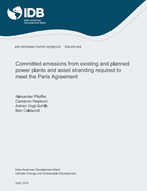Committed Emissions from Existing and Planned Power Plants and Asset Stranding Required to Meet the Paris Agreement
Date
Apr 2018
Over the coming decade, the power sector is expected to invest ~7.2 trillion USD in power plants and grids globally, much of it into CO2-emitting coal and gas plants. These assets typically have a long lifetime and commit large amounts of (future) CO2 emissions. Here, we analyze the historic development of emission commitments from power plants and compare the emissions committed by current and planned plants with remaining carbon budgets. Based on this comparison we derive the likely amount of stranded assets that would be required to meet the 1.5-2°C global warming goal. We find that even though the growth of emission commitments has slowed down in recent years, currently operating generators still commit us to emissions (~300 GtCO2) above the levels compatible with the average 1.5-2°C scenario (~240 GtCO2). Furthermore, the current pipeline of power plants would add almost the same amount of additional commitments (~270 GtCO2). Even if the entire pipeline was cancelled, therefore, ~20% of global capacity would need to be stranded to meet the climate goals set out in the Paris Agreement. Our results can help companies and investors re-assess their investments in fossil-fuel power plants, and policymakers strengthen their policies to avoid further carbon lock-in.




